Overview of Moss Rose
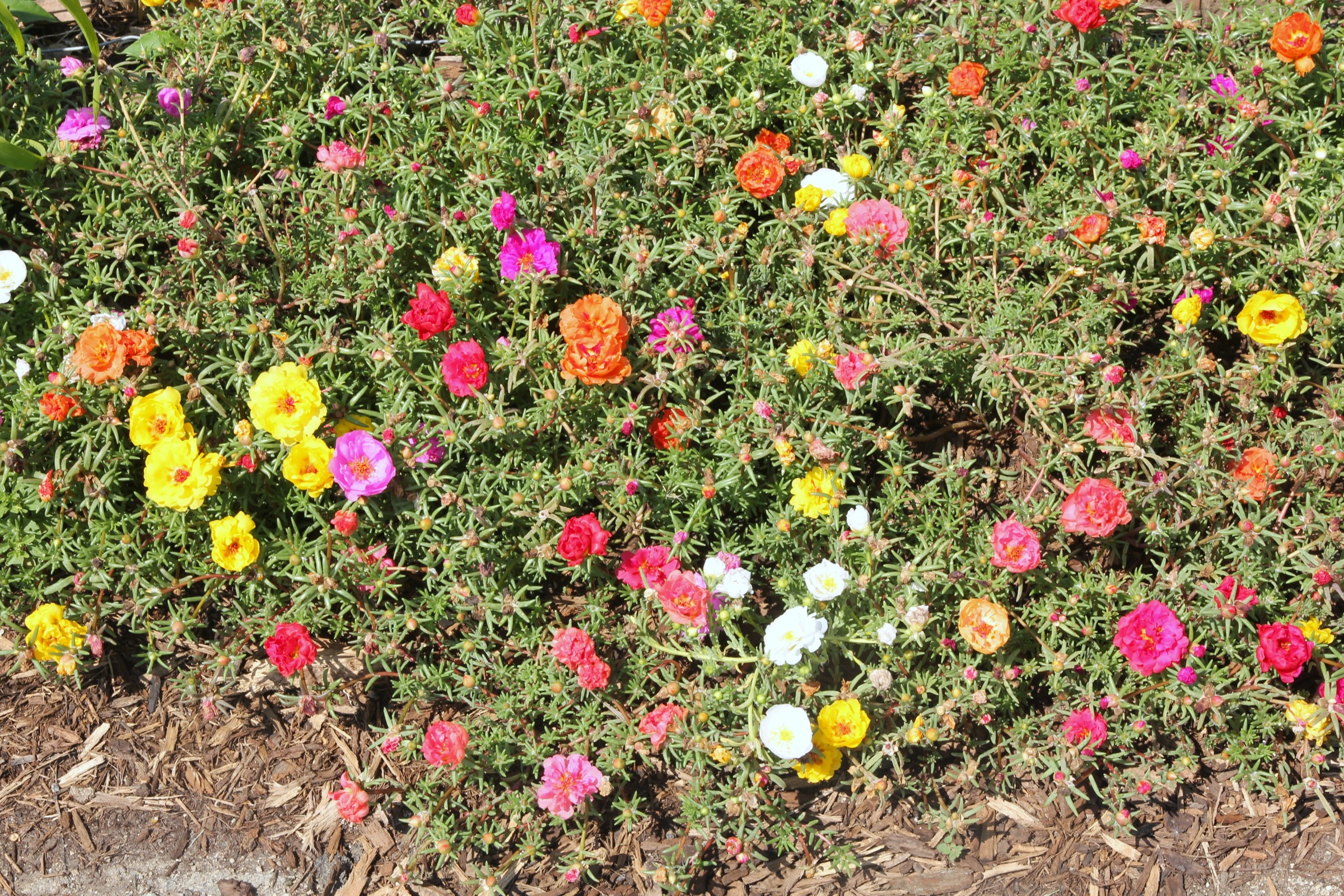

Moss rose, Portulaca grandiflora, is a drought and heat tolerant annual native to hot, dry plains in Argentina, southern Brazil, and Uruguay. This herbaceous plant in the purslane family (Portulacaceae) is cultivated throughout the world as a garden annual for its showy flowers that bloom all summer long with little care. As with its relative common purslane (P. oleracea), it has escaped to naturalize in some parts of the country on roadsides and in waste places. In the ornamental industry moss rose may be listed as P. oleracea, P. umbraticola or P. grandiflora, but many cultivars are likely hybrids.
Moss rose is a semi-succulent plant that stores water in its fleshy leaves and stems. Bright green leaves, up to an inch long, are oblong to cylindrical with pointed tips and are arranged alternately or in small clusters along reddish, multi-branched prostrate to slightly ascending stems.
P. oleracea and hybrids with that species have flat leaves. Stems can be somewhat fragile and break easily (although broken pieces will root if the soil is moist enough). The low-growing plants form a mat up to a foot across and 3 to 8 inches high arising from the central fibrous root system.
The saucer-shaped, rose-like flowers are produced on the stem tips, held facing up above the foliage, opening from buds that resemble little popcorn kernels. They are only open in bright sunlight, closing at night and on cloudy days, but most of the newer hybrids will remain open throughout the day.
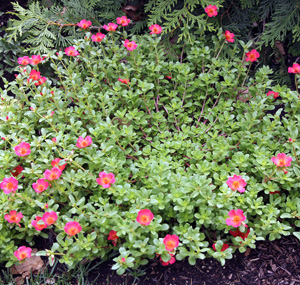
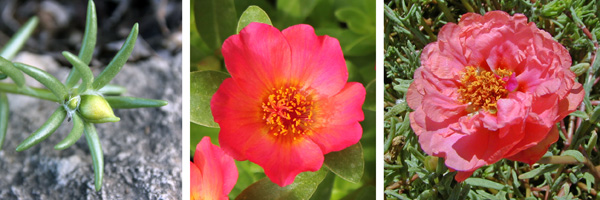
When open the flowers can nearly hide the foliage. Flowers come in white and a wide range of warm colors, including pink, peach, yellow, orange, red, fuchsia, magenta, lavender and purple. Newer cultivars and hybrids offer a greater range of shades than in the species, and some are striped or spotted with contrasting colors.
Each flower has 5 paper thin petals, although semi-double and double types have been developed with multiple sets of petals. Petals surround a group of 40 or more stamens and 5 to 8 stigmas in the center. Depending on the variety, flowers can be 1-3 inches across.
After pollination, rounded 1/8-1/4 inch diameter seed capsules develop. When ripe, they split open, spilling numerous tiny, rounded to elongate, iridescent blue-grey seeds from each capsule. Moss rose often reseeds. The seeds are edible raw or cooked (although it would be time consuming to collect enough to use as food!).

Landscape Use
Moss rose makes a good bedding plant in hot, dry areas where other plants struggle. Use as an edging plant along walkways, as an annual groundcover, or interplanted in bulb beds to cover the ground after the bulb foliage dies back. Moss rose will grow in between rocks and flagstones (but does not tolerate any foot traffic) and looks nice draped over stones in a rock garden or cracks in a rock wall.
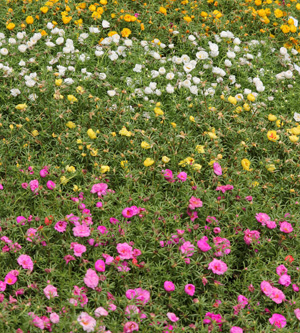
It combines well in containers with other plants that also thrive in hot, sunny sites such as nasturtium and zinnia. The fine texture of moss rose contrasts well with the bold rounded leaves of nasturtium, while its short stature contrasts with all types of zinnias. In containers the brightly colored blossoms show up nicely when planted with ornamental sweet potato vine in either lime green or dark purple (but be aware that the vigorous growth of the sweet potato could easily overrun the smaller moss rose, especially when planted in the ground). Moss rose can also be used in hanging baskets as a trailing plant hanging over the edge of the container.
General Care of Moss Rose
Grow moss rose in full sun in most soil types as long as they are well-drained. It is a good choice for lean, sandy, gravelly or rocky areas. Grow from seed sown directly in the ground or started indoors 4-8 weeks before the average last frost for earlier bloom. Just barely cover the tiny seeds whether sown indoors or out.
Mixing the tiny seeds with sand before sowing will make it easier to scatter them uniformly. Seeds should germinate in 1½-2 weeks. Because they are frost tender, wait until the soil is warmed and the danger of frost has passed to seed or transplant into the garden. Thin the seedlings to 3 inches or more apart. Although moss rose survives difficult conditions, plants will produce more lush growth and flowers when provided sufficient moisture and rich soils. Pinching or deadheading will promote greater flowering and reduce reseeding. Plants can be pruned or sheared in midseason if they begin to look straggly for a neater appearance and to promote fuller growth.
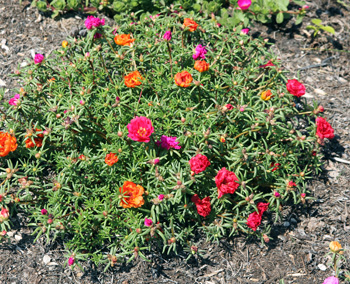
Moss rose has few pest issues, although occasionally aphids or slugs can be a problem. Stem or root rots can be a problem in wet soils. This plant is not favored by deer in most places.
Propagation of Moss Rose
Many moss rose varieties can be propagated by seed. Some newer varieties are propagated through cuttings. Seeds are offered as single varieties and in mixtures.
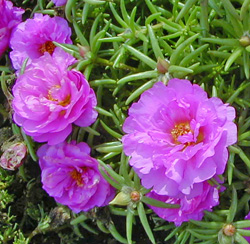
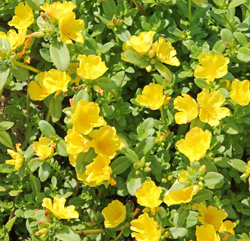

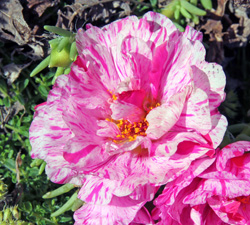
Cultivars of Moss Rose
Many types are available as bedding plants in garden centers and from other retailers in the spring. Some common varieties include:
- ‘Afternoon Delight’ has 2-inch flowers that stay open longer in the afternoon than the species.
- ‘Calpyso Mix’ has bright double flowers in shades of yellow, red, pink, orange, purple and white.
- ‘Duet’ offers bicolor single flowers on compact, free-flowering plants.
- ‘Fairy Tale’ series flowers have a pom-pom of petals in the center and flat outer petals in bright colors. Although listed as P. grandiflora, it has the flat leaves typical of P. oleraceae. The cultivars in this series have appropriate names, such as ‘Cinderella’ for the bicolor yellow and red one, ‘Snow White’ for the all-white version and ‘Sleeping Beauty’ for the yellow.
- ‘Happy Hour’ series is seed propagated and has a reduced photoperiod requirement, so it blooms early in the season. It comes in 8 vivid colors and 3 mixes with tropical names like banana, coconut, lemon, orange and rosita. The plant has a fuller habit than most moss roses and has large, double blooms.
- ‘Margarita’ is a series of compact, mounding, early-flowering plants with flowers in shades of red, pink, orange, white, yellow and purple.
- ‘Mojave’ series has large white, pink, red, tangerine, and yellow flowers.
- MEGA PAZZAZ™ series is a large-flowered, vegetative series available in 10 colors. Varieties have a semi-trailing growth habit and grow 14 to 16 inches tall and 16 to 18 inches wide. ‘Red’ was awarded the Best of Trials Winner in the 2025 Commercial Growers of Wisconsin field trials.
- ‘Rio’ series includes 6 patented vegetative cultivars with large, brightly colored flowers.
- ‘Sundance’ series features semi-double flowers in four colors that remain open most of the day.
- ‘Sundial’ series is early blooming, with double flowers that remain open in cooler and cloudier weather. The compact plants come in nine colors including ‘Fuchsia’ with magenta-pink flowers, ‘Peppermint’ with hot pink-striped white flowers, and white, pink, peach, ‘Mango’ (orange), red and yellow.
- TEQUILA™ series are hybrids with flowers in a mix of colors, such as the red which is red on the outside and yellow in the center. It has been shown to be slightly more tolerant of cool and moist conditions than other types, and is slightly less daylength sensitive than other varieties.
- ‘Yubi Summer Joy’ series includes several colors. All have single blossoms that are nearly three inches across and remain open late in the day. Plants are more trailing and have broad leaves.
– Susan Mahr, University of Wisconsin – Madison
Last Update: Bruce Spangenberg, UW-Madison Extension, 2025





 Marigolds
Marigolds Create a Butterfly Garden
Create a Butterfly Garden Plant Flowers to Encourage Beneficial Insects
Plant Flowers to Encourage Beneficial Insects Forcing Bulbs
Forcing Bulbs


